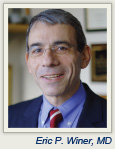Eastern Cooperative Oncology Group (ECOG) trials have demonstrated that recurrence patterns are different for estrogen receptor (ER)-positive vs ER-negative breast cancer. While ER-negative disease carries a high risk for early recurrence—peaking around year 1.5 from diagnosis—risk steadily declines thereafter. ER-positive tumors, on the other hand, actually carry a higher risk of recurrence on an annual basis, as recurrence risk steadily rises. This makes relapse risk for ER-positive patients more common later, rather than sooner, post-treatment.
High-risk Time Period
 “The period of time beyond 5 years is one of relatively high risk for women with ER-positive breast cancer,” said Eric P. Winer, MD, of Dana-Farber Cancer Center, Boston.
“The period of time beyond 5 years is one of relatively high risk for women with ER-positive breast cancer,” said Eric P. Winer, MD, of Dana-Farber Cancer Center, Boston.
We all know that breast cancer can recur many, many years after diagnosis,” he said at an educational session at the 2011 San Antonio Breast Cancer Symposium. “It’s a sobering fact that at year 9 of the MA.17 study (evaluating letrozole after 5 years of tamoxifen), some 3% of women entered the year free of cancer and ended the year with a recurrence.”
Several potential scenarios may explain recurrences among luminal breast tumors, according to Dr. Winer. Very early recurrences (within the first year or two) probably represent primary de novo endocrine resistance. Recurrences between 2 and 5 years may be due to secondary endocrine resistance. After 5 or more years, discontinuation of endocrine suppression, on which tumor quiescence depends, may be a function of “a switch being flipped after a period of tumor dormancy,” he proposed.
“And for women with recurrences 15 to 20 years after diagnosis, I scratch my head and wonder where the tumor was all those years,” Dr. Winer added.
Identification of individual risk is critical. “Our goal is not to treat every patient for 5, 10, or 20 years, but to identify those with the greatest risk for recurrence,” he pointed out.
Lack of Established Treatment
Meanwhile, the best way to manage ER-positive patients after 5 years of endocrine therapy—possibly ameliorating risk for late recurrences—remains unclear. In postmenopausal women, the International Breast Cancer Study Group is evaluating extended aromatase inhibitor use on an intermittent vs continuous schedule. For premenopausal women who finish 5 years of tamoxifen, the lack of an established treatment is even more problematic.
“This is truly an unmet medical need. Most women in this situation simply don’t want to go on another treatment at year 5, and so it’s hard to do a study, in spite of the fact that these women remain at high risk,” Dr. Winer said. “We also must keep in mind that the toxicity of 5-plus years of endocrine therapy can be substantial. Even minor side effects can become deeply troubling over time and they increase nonadherence to treatment,” he added.
“While we have many challenges ahead, I believe that laboratory and clinical advances have put us in a better position than ever before,” he concluded, “to improve the lives of the three-fourths of patients with breast cancer who have ER-positive tumors and who constitute the majority of deaths from breast cancer.” ■
Disclosure: Dr. Winer has been a consultant for Novartis.

